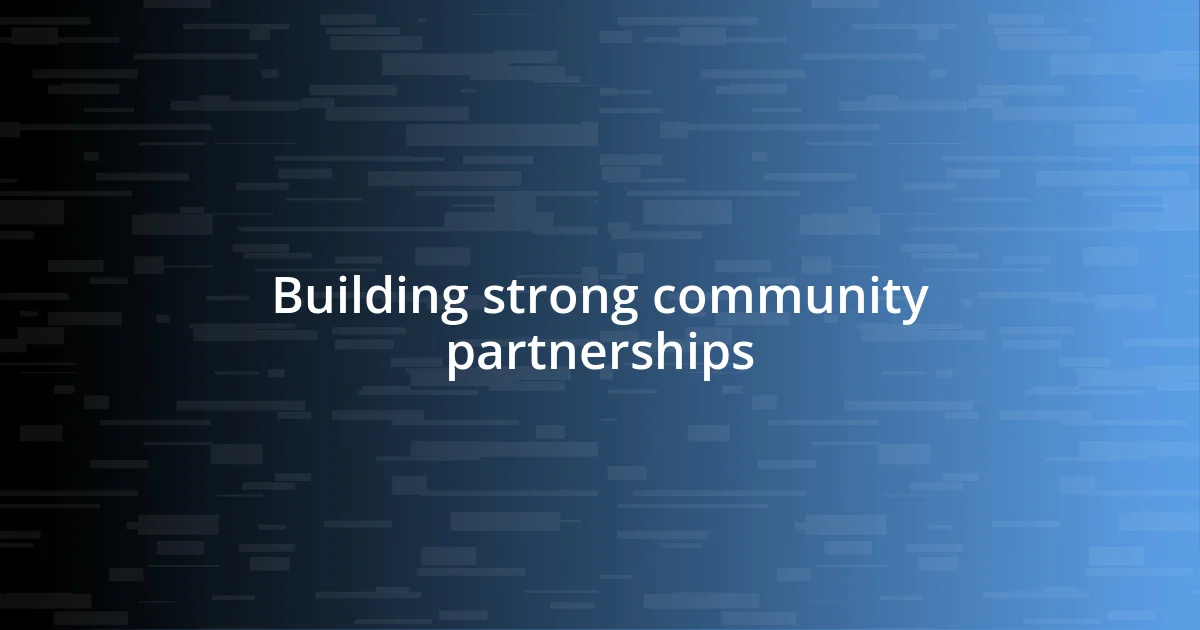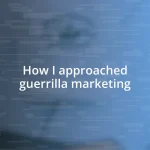Key takeaways:
- Effective community outreach starts with understanding local needs and setting goals that resonate with community values, such as fostering personal growth and addressing social issues.
- Building strong partnerships and engaging stakeholders are crucial for successful outreach efforts, enhancing resource sharing and fostering a sense of community unity.
- Measuring success involves both quantitative metrics and personal stories, highlighting the importance of feedback and reflection to improve future outreach initiatives.

Understanding community outreach goals
When I consider community outreach goals, I can’t help but reflect on that time when I organized a local cleanup event. Initially, it felt daunting to gather volunteers, but my goal wasn’t just about cleaning the park; it was about fostering a sense of community pride and connection among residents. I realized that the heart of outreach lies in setting goals that resonate with the community’s values and needs.
Have you ever thought about how outreach goals can shift the dynamics of a community? For me, targeting educational initiatives not only provided resources but also sparked conversations about the importance of lifelong learning. It was incredibly rewarding to see adults returning to class, fueled by the desire for self-improvement and the belief that they could achieve more. Those moments reinforced my belief that outreach goals should be as much about personal growth as they are about social impact.
The impact of well-defined community outreach goals can be profound. For instance, I once set out to address food insecurity, and as I collaborated with local farmers, we shifted perceptions about donating surplus food. It wasn’t just about filling empty stomachs; it sparked a dialogue around sustainability, resource management, and community support. This experience underscored the importance of aligning our outreach efforts with broader societal issues that people care about. What initiatives have you seen that connect deeply with the community’s aspirations?

Developing effective outreach strategies
When developing effective outreach strategies, I’ve found that a deep understanding of the community’s needs is crucial. For example, during a mental health awareness campaign, I conducted surveys and focus groups that revealed a significant stigma surrounding mental health issues. By addressing concerns directly, we tailored our messaging, which ultimately resonated with the audience and fostered open dialogues. This reinforced the importance of insight-driven approaches in outreach efforts.
To create a successful outreach strategy, consider these key elements:
– Know Your Audience: Understand the demographics, interests, and challenges of the community.
– Set Clear Objectives: Define what you hope to achieve, whether it’s raising awareness, providing services, or building connections.
– Engage Stakeholders: Involve community members and local organizations in the planning process to ensure buy-in and collaboration.
– Utilize Multiple Channels: Leverage various platforms—social media, community boards, and local events—to reach a broader audience.
– Evaluate and Adapt: Regularly assess the effectiveness of your outreach efforts and be willing to adjust your strategy based on feedback and outcomes.
Embracing these strategies not only enhances outreach effectiveness but also nurtures genuine connections within the community, a lesson I learned firsthand while working on a mentorship program.

Building strong community partnerships
Building strong community partnerships is vital for successful outreach. I’ve witnessed firsthand how collaborating with local organizations can amplify our efforts. For instance, when I joined forces with a neighborhood nonprofit for a health fair, we leveraged each other’s resources and networks. This partnership not only brought more participants but fostered a sense of unity that I had never experienced before. Seeing people from different backgrounds come together for a common cause was deeply fulfilling.
Another memorable experience that shaped my view on partnerships happened during a youth mentoring program. I reached out to schools and local businesses, and what struck me was the eagerness to contribute. Many local businesses offered their venues for free tutoring sessions, while schools provided the necessary permission. It reminded me that when we build connections based on trust and a shared vision, the possibilities become endless. Have you ever considered how a simple conversation could lead to impactful collaborations in your community?
Ultimately, successful partnerships require ongoing communication and mutual benefit. I learned this while working with a local art group. By sharing resources, we not only expanded our outreach but also cultivated a vibrant arts scene that involved both young and old. When community members feel invested in a partnership, the results can be transformative, echoing throughout the entire community. What partnerships have you nurtured that led to unexpected successes?
| Key Elements | Importance |
|---|---|
| Collaboration | Strengthens outreach efforts through shared resources. |
| Trust Building | Fosters a supportive environment for joint initiatives. |
| Mutual Benefit | Ensures all partners see value, encouraging longevity. |
| Open Communication | Facilitates adjustments based on feedback and needs. |
| Shared Goals | Aligns all parties towards a common vision and purpose. |

Engaging and mobilizing volunteers
Engaging volunteers effectively often starts with a personalized approach. I remember when I organized a community garden project; I spent time chatting with potential volunteers about their gardening experiences and what they’d like to achieve. This conversation led to a diverse group of individuals who didn’t just show up to plant seeds—they brought their unique skills and ideas, which significantly enriched the project. Have you ever noticed how fostering personal connections can ignite enthusiasm among volunteers?
Once you’ve established that rapport, it’s essential to provide clear roles and responsibilities. I learned this while managing a beach cleanup where I assigned specific tasks based on each volunteer’s interests. By allowing them to choose how they could contribute, I saw a marked increase in motivation and teamwork. When people feel ownership over their roles, they’re far more likely to engage passionately with the mission at hand.
Moreover, regular recognition of volunteers’ efforts goes a long way in cultivating a supportive community. After we completed several successful events, I made it a point to highlight individual contributions during follow-up meetings. The appreciation expressed created a ripple effect, encouraging others to step up and share their ideas. Have you ever experienced the boost in morale that comes from simple acknowledgment? It can transform engagement levels and inspire ongoing participation.

Measuring outreach success and impact
Measuring the success of community outreach can often feel like navigating a maze. One effective approach I’ve found is utilizing both quantitative and qualitative metrics. For example, during a literacy program I implemented, I tracked attendance and reading assessment scores, but equally important were the personal stories shared by participants about how the program impacted their lives. Have you ever considered how a simple anecdote can hold as much weight as the numbers?
Another key aspect is gathering feedback from the community. After running a youth arts initiative, I distributed surveys to participants and their parents. The insights we gained were invaluable; not only did we learn about areas for improvement, but we also celebrated the moments that brought joy. I remember one mother sharing how her child’s confidence soared from creating public art. It’s moments like these that remind me that success isn’t only about the numbers but the stories behind them.
I also encourage setting clear, shared goals with all stakeholders involved. During a health fair, we agreed on specific outcomes, such as the number of screenings provided and the level of community engagement we sought to achieve. Afterward, reflecting on what we accomplished compared to our goals allowed us to adjust our strategies for future events. It’s so rewarding to build collective ownership over success. Have you reflected on the outcomes of your outreach initiatives? Those reflections can often guide us to new heights of impact.

Sharing success stories and lessons
Sharing success stories plays an essential role not only in celebrating achievements but also in inspiring others to take action. I recall a time when we showcased the transformation of a local park that had thrived due to community engagement. Seeing the before-and-after photos projected at an event sent a wave of excitement through the audience. Have you ever felt that surge of inspiration when you witness the impact of collective effort? It certainly reminded me that sharing our successes can motivate others to get involved.
Lessons learned from each project are just as vital as the successes themselves. During a food drive, I underestimated the importance of timely communication and logistics. Next time, I made it a point to create a detailed timeline and keep everyone informed. This not only streamlined our efforts but also fostered greater trust among volunteers. Have you ever encountered a setback that turned into a valuable lesson? Reflecting on those experiences can profoundly shape our future outreach strategies.
I also believe that storytelling extends beyond personal achievements; it fosters a sense of community. I remember co-hosting a sharing circle where volunteers shared their experiences and the lives they touched through their service. It became evident that every person had a unique success story, reinforcing our shared mission. Isn’t it fascinating how stories can connect us and amplify our outreach impact? Recognizing, celebrating, and learning from each other can create a powerful ripple effect that strengthens our community’s bonds.

Expanding outreach for future growth
As I think about expanding outreach for future growth, I can’t help but recall the moment when my team and I decided to partner with local businesses for our mentoring program. It wasn’t just about seeking sponsorships; we wanted to forge genuine connections that would benefit both the mentors and the youth. Have you ever experienced the joy of forming a partnership that feels just right? This collaboration not only increased our resources but also enriched the participants’ experiences, showing me that the right partnerships can create a lasting impact within the community.
Furthermore, creating inclusive outreach strategies has proven essential in reaching diverse audiences. For instance, we hosted workshops in different languages to ensure everyone felt welcomed. One participant shared how their entire family attended a session, something they hadn’t done before due to language barriers. This moment highlighted that outreach is about breaking down walls, doesn’t it? By recognizing and addressing the unique needs of various community segments, we pave the way for future growth and deeper relationships.
Finally, leveraging technology has opened up new avenues for outreach. During the pandemic, I pivoted to virtual events and discovered an unexpected variety of participation. I remember an elderly participant who shared that they hadn’t felt so connected in years because Zoom allowed them to engage from the comfort of their home. Have you considered how technology could enhance your outreach initiatives? It’s incredible to see how adapting to change can not only maintain but grow community connections in ways we never imagined.














